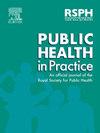Reducing health inequalities in disasters: A cross-sectional study of the viability of ‘vulnerability’ terminology and of priority lists in the UK
IF 1.9
Q2 PUBLIC, ENVIRONMENTAL & OCCUPATIONAL HEALTH
引用次数: 0
Abstract
Background
In disasters, people with certain characteristics repeatedly experience health inequalities. In the UK, people predicted to experience poorer health outcomes are often described as ‘vulnerable’. Various services compile lists of ‘vulnerable’ people eligible for interventions in disasters to reduce health disparities.
Study aim
To explore the viability of current approaches to reducing health inequalities in disasters, we tested whether people typically described as ‘vulnerable’ by public health and emergency planners self-identify as 'vulnerable' in a disaster, and whether they are registered on a ‘vulnerability list’.
Study design
We collected data from 5148 UK-based adults using a cross-sectional online survey from July–September 2022, using nationally representative quotas for age, gender, disability, and social grade.
Methods
We calculated the proportions of respondents with perceived indicators of ‘vulnerability’ who self-described as 'vulnerable during a disaster’, and who reported being on a Priority Service Register or another ‘vulnerability list’. We used odds ratios to assess whether access to resources or risk mitigation plans explained low rates of self-identification as 'vulnerable' and registration.
Results
Among people with perceived indicators of 'vulnerability', self-description as ‘vulnerable in a disaster’ ranged from 22.4 % (of people dependent on false teeth) to 60.7 % (of people reporting significant difficulty running errands alone). Registration on a Priority Service Register ranged from 11.4 % (of people who were pregnant) to 35.7 % (of people reporting difficulties dressing, bathing, or using the toilet independently). Respondents without alternative plans or resources were generally no more likely to consider themselves ‘vulnerable’ or be registered on a 'vulnerability list' than those with alternative plans or resources.
Conclusions
Communications using the term 'vulnerable' may not reach target audiences. Using priority lists to reduce health disparities is impractical as most people facing inequitable risk are not registered. We suggest shifting UK terminology and discourse surrounding disaster risk, focussing on making mainstream strategies inclusive and accessible to reduce health inequalities in disasters.
减少灾害中的卫生不平等:联合王国“脆弱性”术语和优先事项清单可行性的横断面研究
在灾难中,具有某些特征的人反复经历健康不平等。在英国,预计健康状况较差的人通常被描述为“脆弱”。各种服务机构编制了在灾害中有资格接受干预措施的“弱势”人群名单,以缩小健康差距。研究目的为了探索当前减少灾害中健康不平等的方法的可行性,我们测试了通常被公共卫生和应急计划者描述为“脆弱”的人在灾难中是否自我认同为“脆弱”,以及他们是否被登记在“脆弱名单”上。研究设计我们在2022年7月至9月期间通过横断面在线调查收集了5148名英国成年人的数据,使用了具有全国代表性的年龄、性别、残疾和社会等级配额。方法我们计算了具有感知到的“脆弱性”指标的受访者的比例,他们自称“在灾难中脆弱”,并报告在优先服务登记册或另一个“脆弱性名单”上。我们使用优势比来评估获得资源或风险缓解计划是否解释了自我认同为“脆弱”和登记的低比率。结果在感知到“脆弱”指标的人群中,自我描述为“在灾难中脆弱”的比例从22.4%(依赖假牙的人)到60.7%(报告独自跑腿有很大困难的人)不等。在优先服务登记册上登记的人数从11.4%(孕妇)到35.7%(报告有独立穿衣、洗澡或上厕所困难的人)不等。没有替代计划或资源的受访者通常不会比那些有替代计划或资源的受访者更容易认为自己“脆弱”或被登记在“脆弱名单”上。使用“脆弱”一词的传播可能无法触及目标受众。使用优先清单来减少健康差距是不切实际的,因为大多数面临不公平风险的人没有登记。我们建议改变英国围绕灾害风险的术语和话语,重点是使主流战略具有包容性和可及性,以减少灾害中的卫生不平等。
本文章由计算机程序翻译,如有差异,请以英文原文为准。
求助全文
约1分钟内获得全文
求助全文

 求助内容:
求助内容: 应助结果提醒方式:
应助结果提醒方式:


